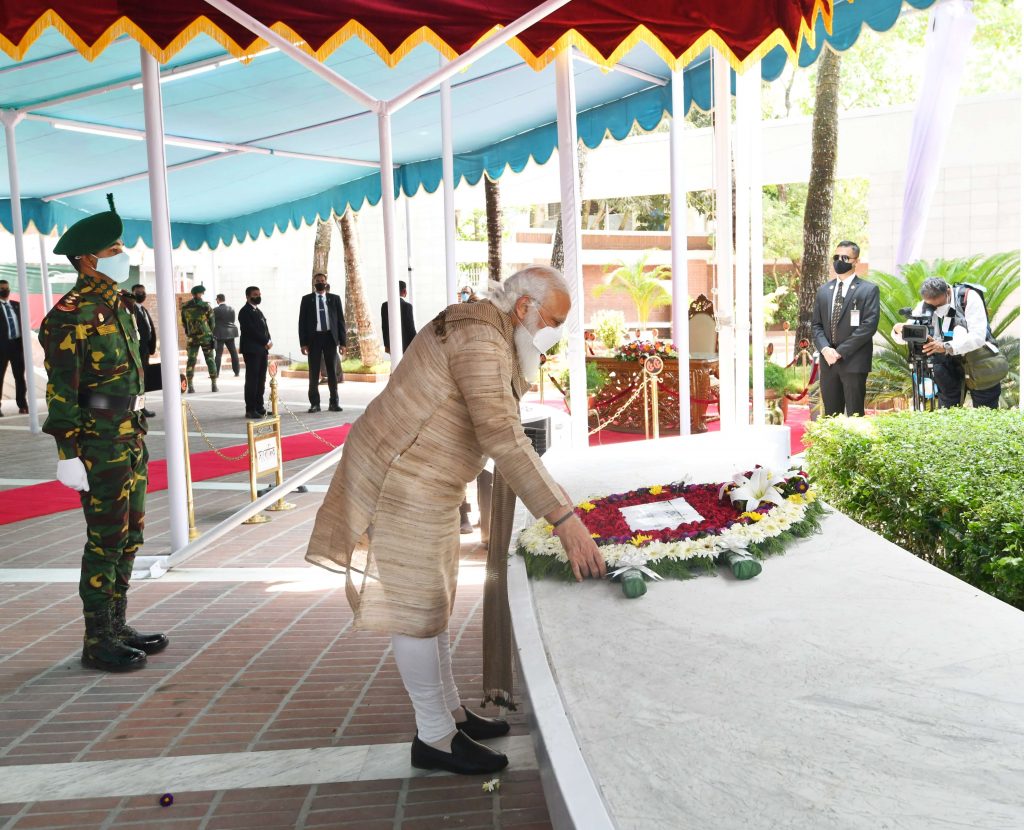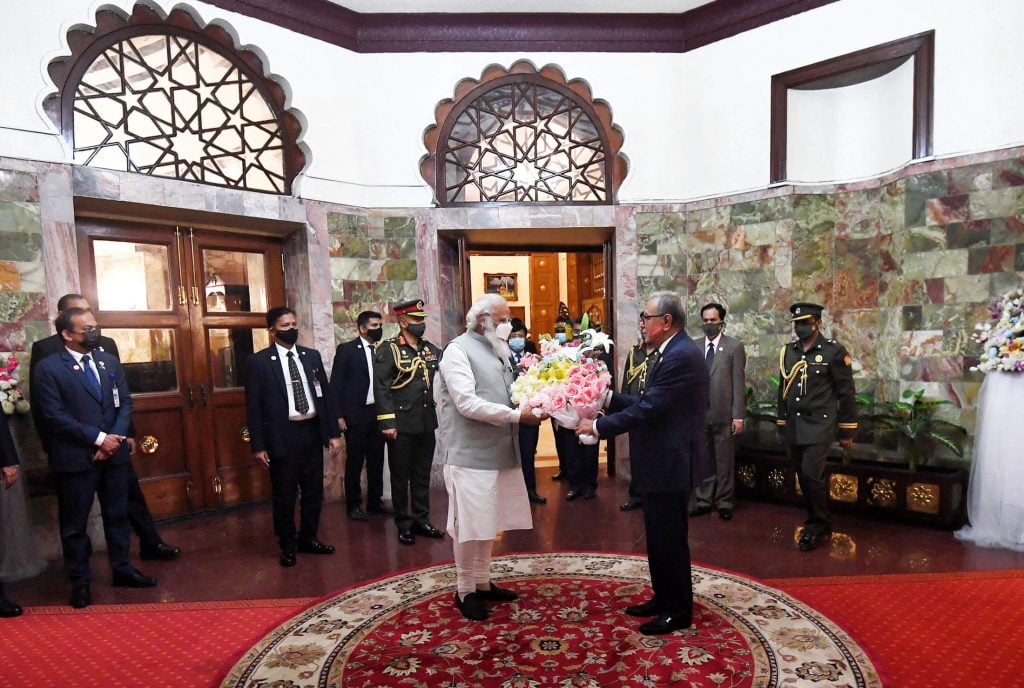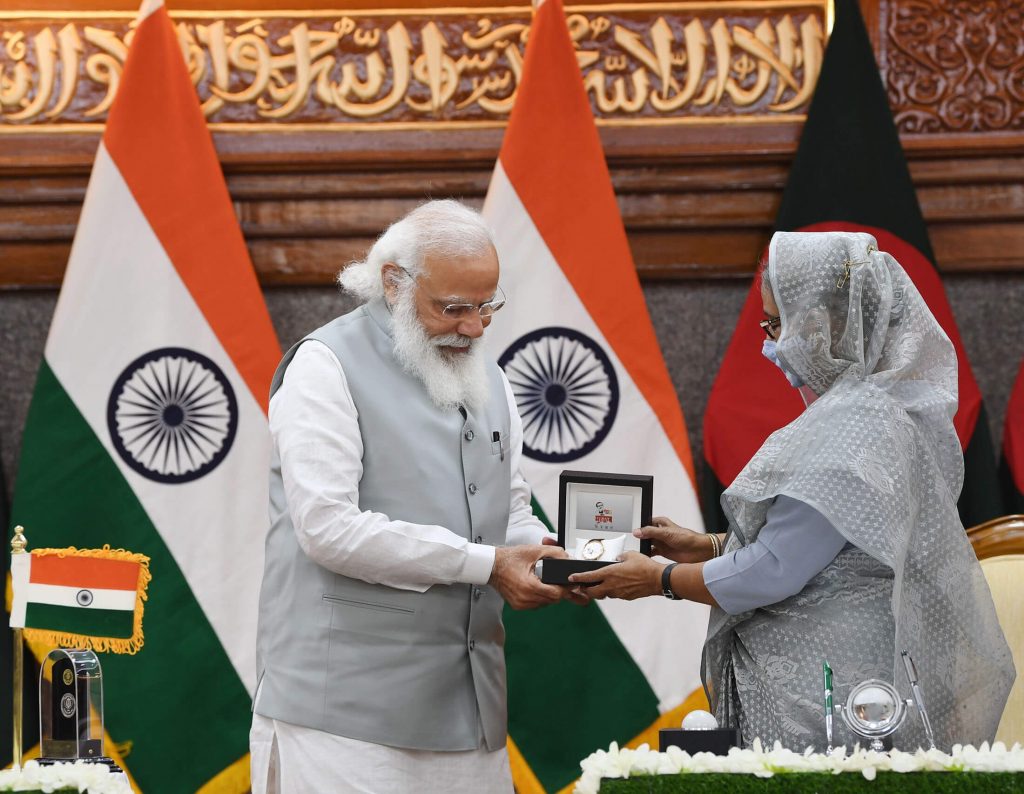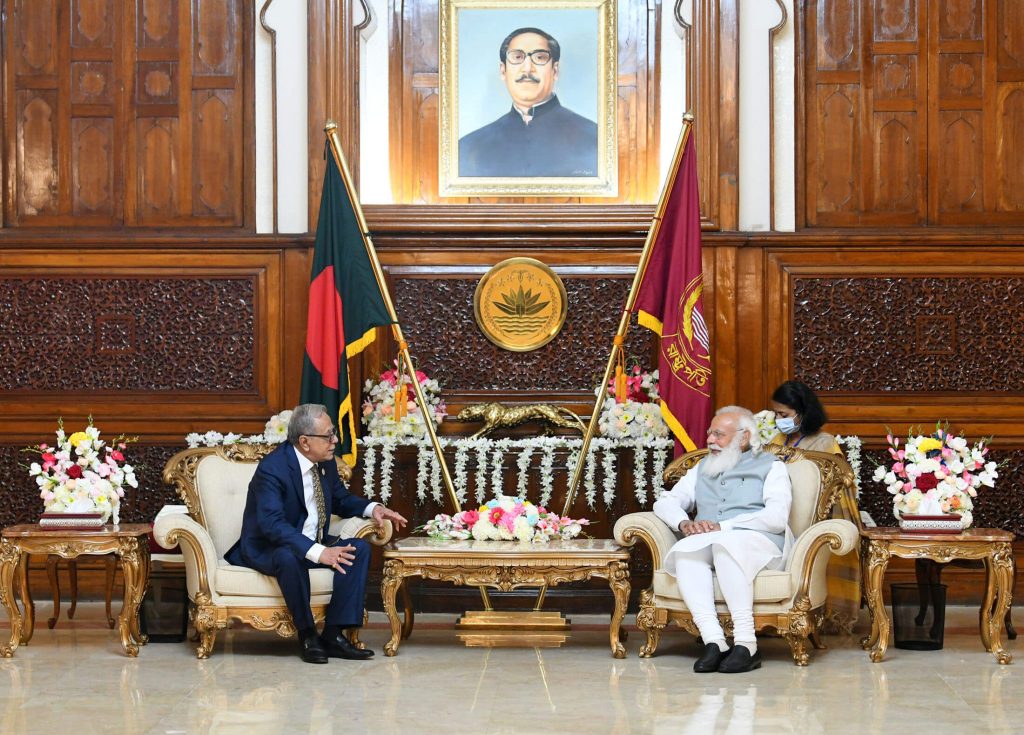
Bangladesh celebrated its 50th year of independence on 26 March 2021. It also coincides with 50 years of Indo- Bangladesh relationship and the 101st birth anniversary of Sheikh Mujibur Rahman, the father of the nation of Bangladesh. India has conferred the Gandhi Peace Prize for 2020 to Sheikh Mujibur Rehman as recognition of his contribution to promoting peace in the Indian subcontinent. To commemorate the event, it was but natural for Prime Minister Narendra Modi to be invited to attend the golden jubilee celebrations of Bangladesh’s independence.
The bloody past
India played a very important role in the liberation of Bangladesh. Pakistan commenced its brutal crackdown and committed genocide and atrocities on the hapless citizens of then East Pakistan (now Bangladesh) in March 1971. It led to the killing of almost three million Bangladeshi and hundreds of thousands of rapes by Pak forces. One day later, Sheikh Mujibur Rehman declared independence. Almost ten million people fled East Pakistan and took refuge in India. Indian army provided moral support, weapons and training to Mukti Bahini, an armed guerrilla force that fought against the Pakistani army for the liberation of Bangladesh.
The Government of India, on 3rd December 1971, declared war with Pakistan to save Bengali Muslims and Hindus. This war was fought between India and Pakistan for 13 days. On 16th December 1971, the chief of the Pakistani forces with 93,000 soldiers surrendered unconditionally to the Indian Army in Dhaka. Bangladesh was born on this day.

Ups and downs in relations
India was one of the first countries to recognize Bangladesh and establish diplomatic relations immediately after its independence in December 1971. Fifty years ago, Prime Minister Indira Gandhi and Prime Minister Sheikh Mujibur Rahman, signed a 25-year treaty of friendship and cooperation between their two countries. Bilateral ties between Bangladesh and India flourished till 1975. Sheikh Mujibur Rehman along with his family was assassinated on August 15, 1975, in a cruel coup d’état. The army took control and Bangladesh was consigned to military rule. The relations between the two countries got severed thereafter and India was no longer seen as a political ally.
In 1996, Awami League came to power and bilateral ties began improving. But again, between 2001 and 2006, the relationship reached rock bottom when the Bangladesh Nationalist Party (BNP) and the Jamaat-e-Islami’s alliance formed the government. This regime was often blamed for sponsoring insurgency activities in the north-eastern states of India. Sheikh Hasina, (daughter of Mujibur Rehman) of Bangladesh Awami League once again became the Prime Minister in 2008, 2014, 2018 and continues to do so.
She was responsible for restoring the historic ties that Bangladesh had with India. It decisively neutralised all prominent national security threats to India by pursuing a zero-tolerance strategy against all forms of terrorism. It is because of her that support to insurgents of the north-eastern states of India was stopped. She has respected India’s security needs and in turn, Delhi has backed her both politically and economically. Hasina has also been successful in overseeing the economic transformation of Bangladesh. Most recently, the IMF’s economic projection points out that the per capita income of Bangladesh is expected to remain at par with India till 2025 — a feat unimaginable in 1972.
Areas of concern
For Bangladesh’s people, the failure of Dhaka and Delhi to reach a deal on an equitable sharing of the river Teesta’s waters remains a major concern. With India and Bangladesh crisscrossed by 54 common rivers, the solution to Teesta water sharing remains elusive.

India and Bangladesh share 4096.7 km. of the border, which is the longest land boundary that India shares with any of its neighbours. The India-Bangladesh Land Boundary Agreement (LBA) came into force following the exchange of instruments of ratification in June 2015. The ratification of the Land Boundary Agreement by India earned the appreciation of Bangladeshis. Though a major portion of the boundary has been fenced but still the areas are porous and riverine which cannot be fenced and migration, smuggling and human trafficking continue to be an area of concern.
The Modi government’s enactment of the Citizenship Amendment Act (CAA) and plans to implement the National Register of Citizens (NRC) has triggered apprehension over an impending exodus of Bengali-speaking people from Assam to Bangladesh. People in Bangladesh are concerned about CAA in India. They remain wary of conditions that might develop in Assam, with probable ramifications for Bangladesh.
Bangladesh is India’s biggest trade partner in South Asia. India’s exports to Bangladesh are nearly eight times more than the imports from Bangladesh. There is certainly a gap in terms of exports and imports, but again, it is geography which has often determined conditions. While India has given duty-free access to several Bangladeshi goods, but the gap between the countries’ exports to each other seems worrying. For Dhaka, the redeeming factor is its economy, which is currently one of the fastest-growing in the world.
Currently, Bangladesh is an active partner of the belt and road initiative (BRI) of China that Delhi has not signed up to. In the security sector, Bangladesh is also a major recipient of Chinese military inventory, including submarines. Beijing’s enhanced push in Bangladesh is also an area of concern for India.
Signing the visitor book at the Mausoleum complex Prime Minister Modi wrote: “The life of Bangabandhu epitomized the freedom struggle of the people of Bangladesh for their rights, for the preservation of their inclusive culture and their identity.”
Why Bangladesh is important?
India and Bangladesh share historical, civilizational and cultural ties; Bengali, which is spoken in both countries, is a strong bond. Bangladesh will always remain unique for several reasons to India. It is one neighbourhood where all of India’s interests converge. The geography dictates the destinies of India and Bangladesh as these two neighbours remain inseparably intertwined. A similar feeling also exists among the people of India’s northeast as this land-locked region can have an entirely different future through the gateway of Bangladesh. In other words, from the perspective of India’s Northeast, Bangladesh is India’s most strategic neighbour, whom New Delhi cannot ever afford to ignore. It is a gateway for India’s ‘Look East Policy’.

Bangladesh assumes greater importance due to its strategic location to influence the Indo-pacific region. In view of the growing importance of this region, the expansion and modernisation of Mangla and Chattogram ports in Bangladesh will play a major role in future. It could also be included as a member of the extended ‘Quad’ in future.
Way forward
The first 50 years have consolidated the foundation of India-Bangladesh relations. The future will present itself with an abundance of opportunities to help the two countries to reach a new plane of bilateral relations higher than ever before, provided that the leadership of the two neighbours play their diplomatic cards with more maturity and pragmatism, keeping the regional aspirations and nuances of both the countries in mind. A judicious aggregation of regional expectations on both sides of the border will help in achieving their mutual national objectives.
Both the countries have been actively working towards better connectivity between the two countries. A lot of disused roads and rail links have been re-established, inland waterways improved, and bridges have been built to improve the connectivity. Recently, the “Maitri Setu” bridge over the Feni river in Tripura was inaugurated by Prime Minister Modi, where he emphasised creating “HIRA”- a mesh of highways, information ways, railways, and airways between the two countries. We need to look at improving airways between the two countries through the northeast. The untapped trade potential between the two countries can be exploited through better connectivity. Improved connectivity with Bangladesh will protect the north-eastern states of India from Chinese influence. It will also lead to improved government to government, business to business and people to people relationship.
Both the countries have a lot at stake and should take this special friendship between the two nations forward. Successful vaccine diplomacy initiative has allowed Bangladesh to access Oxford’s AstraZeneca vaccine. Its symbolic importance is likely to pave way for many contentious political negotiations, such as water-sharing agreements concerning the river Teesta, frequent border disputes, migration problem, smuggling and human trafficking, disaster management etc. As far as NRC is concerned, India needs to make a careful distinction between bilateral relationship and domestic political imperatives of the ruling party. While Dhaka has calmed tempers, due to India’s assurance that this is a purely internal matter, the framing of the issue remains a sore point. Rohingya crises is another issue that needs attention.

The next logical step should be nurturing economic cooperation by encouraging business to business contact between the two countries. As both nations expect to grow economically over the foreseeable future, there is a lot to gain from well-structured economic cooperation. And if win-win economics are pursued effectively, then there is little doubt that both countries will make their economic presence felt in the region. The two countries need to focus on priority areas, such as investments, presence of non-tariff barriers, the effective execution of the lines of credit that Bangladesh has received from India, cross border energy cooperation through power and pipelines, use of Bangladesh ports for trade and commerce especially the north-eastern region. India can also assist Bangladesh to connect with Nepal and Bhutan and export its products to these countries.
The ground level stakeholders also need to be nurtured to win the battle of hearts and minds across the national borders. The new generation in Bangladesh is blissfully ignorant about the role played by India in the birth of Bangladesh. Steps must be taken to keep the horrific memory of genocide by Pakistani forces and the support provided by India alive, lest we forget. Regular exchanges between civil society on areas such as culture, music, sports, films, human resource development needs to be pursued both through social media and physical meetings. Steps must be taken to encourage more exchanges of people from both sides of the border. Bangladesh holds enormous tourism potential and integrating it with tour packages of the North-eastern states of India would be a game-changer and could also attract the younger generation in Bangladesh to visit India.
Conclusion
The future of India’s Act East Policy, stability and development in the Northeast, economic integration in the larger region, cross border flow of people and peace and security are contingent on ties with Dhaka. In the final analysis, the cooperation can only deliver when it is founded on trust and continuous engagement that culminates with respect for each other. Respecting each other’s sovereignty and interests, within an inclusive, connected and democratic region is the best road map for the future.

